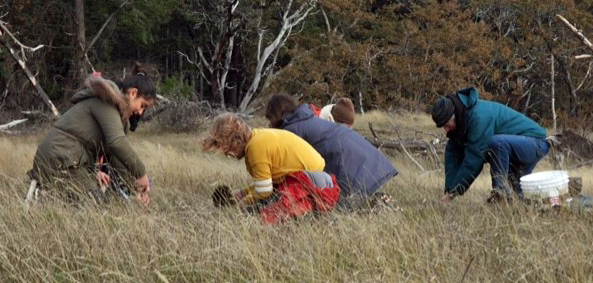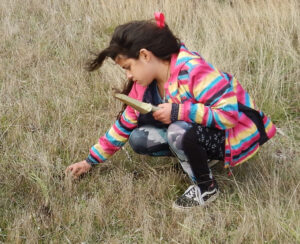Cooperation Key to Helliwell Coastal Bluff Restoration Project
By Chris Junck, Taylor’s Checkerspot Recovery Project Team

Volunteers practiced COVID-19 safety protocols while planting. Photo by Barb Biagi.
Participants at a planting event in Helliwell Provincial Park in late October were undaunted by cold weather and COVID-19. They were determined to help restore part of the park’s coastal bluff ecosystem by replacing invasive weeds with native grass. It was a great cooperative effort involving 19 students, staff and volunteers from Hornby Island Community School, volunteers from the Hornby Natural History Society, a BC Parks volunteer and staff, and members of the Taylor’s Checkerspot Recovery Project Team. Working quickly, they managed to remove about 900 weeds and plant 700 native California Brome grass plugs in less than two hours! The plugs were grown from seeds sewn in small plastic trays by Hornby Natural History Centre volunteers.

Hornby Island Community School students were excited to help plant California Brome grass plugs. Photo by Bonnie Zand.
“I’m totally impressed with the hard work and enthusiasm of the students”, said Taylor’s Checkerspot Recovery Project Team member Bonnie Zand. “They completely exceeded our expectations, and the native pollinators are sure to benefit from the habitat that they are helping to restore.”
Neil Wilson, a member of the Hornby Natural History Centre, added, “I think all of the participants got a good positive feeling that day. This important restoration project is an integral component of Hornby Natural History Centre’s mandate to help actively educate people on the workings of nature. Our members are happy to see our efforts in propagating, nurturing and planting these native plants come to fruition.”
The coastal bluff ecosystem restoration project in Helliwell Provincial Park has been on-going since 2015. Under the direction of BC Parks, it involves community volunteers, contractors, and members of the Taylor’s Checkerspot Recovery Project Team. The project includes the gradual removal of Douglas-fir and Shore Pine that are encroaching on the meadow. The removal of these conifers can leave areas of bare soil that are susceptible to invasion by non-native species such as Canada and Bull Thistle, Hairy Cat’s Ear and Orchard Grass. Replacing the invasive plants with native species is an integral part of the restoration process.
A key goal of the restoration project is to enhance the habitat for pollinators, including recently reintroduced Taylor’s Checkerspot butterflies. Nearly 800 caterpillars of the endangered species were released in the park’s meadows in the spring of 2020, and adult Taylor’s Checkerspots were seen flying in the park in May for the first time since the 1990s!
The Taylor’s Checkerspot Recovery Project Team wishes to thank all of the planting event participants: Judi Ayers and her students, Lisa Hamilton, Ondrea Rogers, Maleen Mund, Neil Wilson, Barb Biagi, Tina Wai, Bill Hamilton, Ruth Goldsmith, Erica McClaren, Heather Steere, and Bonnie Zand.